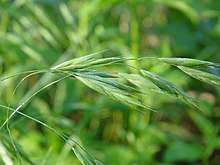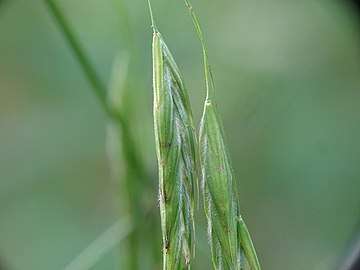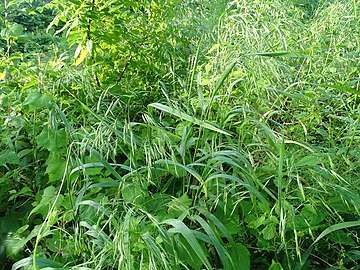Bromus latiglumis
Bromus latiglumis, the earlyleaf brome, is a grass native to North America. The specific epithet latiglumis is Latin for "broad-glumed", referring to the wide glumes.
| Bromus latiglumis | |
|---|---|
 | |
| Scientific classification | |
| Kingdom: | Plantae |
| Clade: | Tracheophytes |
| Clade: | Angiosperms |
| Clade: | Monocots |
| Clade: | Commelinids |
| Order: | Poales |
| Family: | Poaceae |
| Subfamily: | Pooideae |
| Genus: | Bromus |
| Species: | B. latiglumis |
| Binomial name | |
| Bromus latiglumis | |
Description
Bromus latiglumis is a perennial grass that grows in mats or clumps 0.5–2 m (1 ft 8 in–6 ft 7 in) tall. The leaves are cauline. Sheaths are ribbed and glabrous, covering most nodes. The dark green leaf blades are 5–17 mm (0.20–0.67 in) wide with a white midrib. The ovoid panicle is 15–30 cm (5.9–11.8 in) long. The branches of the panicle are either spreading or reflexed and have large basal pulvini. The branches solitary or occur in pairs. The elliptical or oblong spikelets are 1.5–3.5 cm (0.59–1.38 in) long and 5–9 mm (0.20–0.35 in) broad. The spikelets are loosely flowered with three to eight flowers on each spikelet. The glumes are either pilose or glabrous. The five to seven nerved lemmas are 3–4 mm (0.12–0.16 in) long and are mostly glabrous though sericeous towards their base. The awns are 2–6 mm (0.079–0.236 in) long. The palea has a rounded tip and the anthers are 1.5–2.5 mm (0.059–0.098 in) long.[1]
The grass flowers from August to September. The grass occurs in wet woods and prairies, stream banks, and alluvial plains.[2]
 close-up of spikelets
close-up of spikelets plant form
plant form
References
- Merrit Lyndon Fernald (1970). R. C. Rollins (ed.). Gray's Manual of Botany (Eighth (Centennial) - Illustrated ed.). D. Van Nostrand Company. p. 100. ISBN 0-442-22250-5.
- Anna B. Gardner; Michael Hurst; Lynn G, Clark; Deborah Lewis (2014). Grasses in Your Pocket: A Guide to the Prairie Grasses of the Upper Midwest (reprint ed.). University of Iowa Press. ISBN 9781609382384.